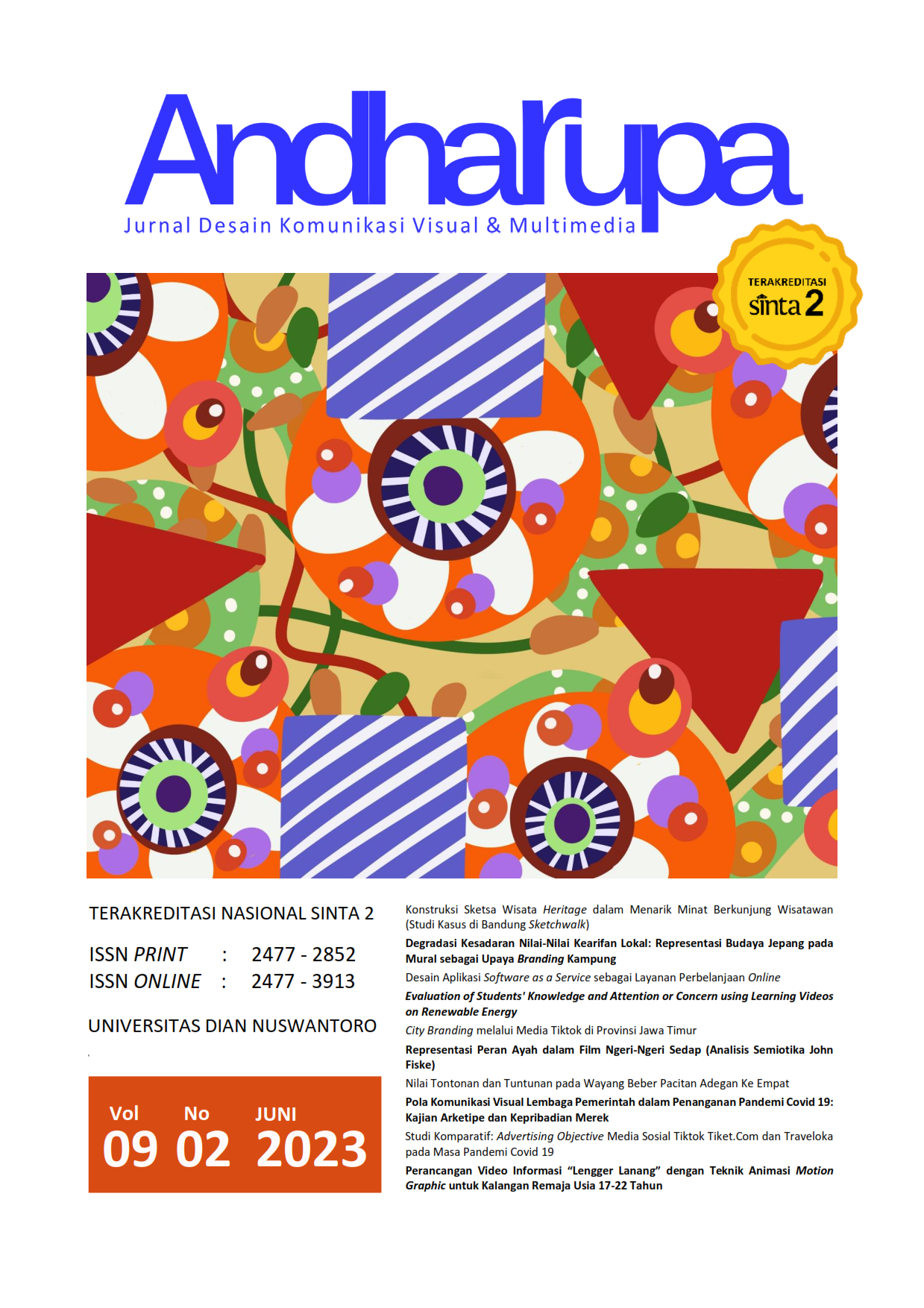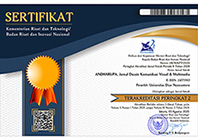Degradasi Kesadaran Nilai-Nilai Kearifan Lokal: Representasi Budaya Jepang pada Mural sebagai Upaya Branding Kampung
DOI:
https://doi.org/10.33633/andharupa.v9i02.8236Abstract
AbstrakMasuknya budaya asing ke Indonesia yang semakin masif di era global dan digital saat ini tidak bisa lagi ditolak maupun dihindari. Keberadaan budaya luar ini dapat mengkuatirkan bila dipahami serta dihayati berlebihan oleh warga bangsa khususnya generasi muda. Persoalan untuk mencintai dan melestarikan budaya lokal semakin rentan terhadap terkikis jati diri generasi penerus bangsa ini. Tujuan studi ini untuk mengungkap mural dengan konsep “Japanese culture” di ruang publik sudut di Yogyakarta dengan cara mendeskripsikan serta mengalisis fenomena visual tersebut. Metode visual (Visual Methodologis) dari Gillian Rose (2001) jenis kualitatif deskriptif-kritis digunakan untuk memaparkan secara komprehensif dengan dibantu berbagai literatur. Studi ini menghasilkan temuan bahwa konsep mural untuk branding kampung kurang mendapatkan pemahaman secara menyeluruh, sehingga dapat menurunkan kesadaran atas nilai-nilai lokalitas yang sepantasnya dijunjung tinggi warganya. Kata kunci: branding, budaya Jepang, degradasi, kesadaran, kearifan lokal, mural, nilai AbstractThe entry of foreign culture into Indonesia, which is increasingly massive in the current global and digital era, can no longer be denied and avoided. The existence of this foreign culture will be worrying if it is understood and internalized excessively by the nation's citizens, especially the younger generation. Efforts to love and preserve local culture must continue to be increased for the younger generation, who are increasingly vulnerable. However, the problem arises because of the increasingly eroded identity of the nation's next generation in loving and preserving local culture. This study aims to reveal a mural with the concept of "Japanese culture" in a corner public space in Yogyakarta by describing and analyzing this visual phenomenon. The visual method (Visual Methodology) from Gillian Rose (2001) qualitative-descriptive-critical is used to explain comprehensively supported by various literature. This study found that the murals for village branding need to be thoroughly understood to reduce awareness of local values that the community members should uphold. Keywords: awareness, branding, degradation, Japanese culture, local wisdom, murals, valuesReferences
Aisara, F., Nursaptini, N., & Widodo, A. (2020). Melestarikan kembali budaya lokal melalui kegiatan ekstrakulikuler untuk anak usia sekolah dasar. Cakrawala Jurnal Penelitian Sosial, 9(2), 149–166. https://ejournal.uksw.edu/cakrawala/article/view/4411
Ariprahara, G. (2012). Kajian analisis identifikasi iklan luar ruang wall painting. Visualita, 4(1), 1–24.
Bahren; Hidayat, Herry Nur; Sudarmoko; Setyaka, V. (2014). Industri Kreatif Berbasis Potensi Seni Dan Sosial Budaya di Sumatera Barat. Jurnal Ekspresi Seni, 16(1).
Berleant, A. (2010). Sensibility and Sense, The Aesthetic Transformation the of Human World. Imprint Academic.
Braun, E., Kavaratzis, M., &, & Zenker, S. (2013). My city – my brand: the different roles of residents in place branding. Journal of Place Management and Development, 6(1), 18–28.
Fernández-Cavia, J., Díaz-Luque, P., Huertas, A., Rovira, C., Pedraza-Jiménez, R., Sicilia, M., Gómez, L., & Míguez, M. (2013). Destination brands and website evaluation: A research methodology. Revista Latina de Comunicación Social, 68, 622–638.
Ghozali, H. (2008). Kearifan lokal (local wisdom). DetikNews. https://news.detik.com/opini/d-1037345/kearifan-lokal-local-wisdom
Giroux, H. A. (2010). Rethinking Education as the Practice of Freedom: Paulo Freire and the Promise of Critical Pedagogy. Policy Futures in Education, 8(6), 715.
Kavaratzis, M., &, & Ashworth, G. J. (2005). City branding: An effective assertion of identity or a transitory marketing trick? Tijdschrift Voor Economische En Sociale Geografie, 96, 506–514.
Mubah, A. S. (2011). Strategi meningkatkan daya tahan budaya lokal dalam menghadapi arus globalisasi. Jurnal Unair: Masyarakat, Kebudayaan, Dan Politik, 24(4), 302–308. http://journal.unair.ac.id/MKP@strategi-meningkatkan-daya-tahan-budaya-lokal-dalam-menghadapi-arus-globalisasi-article-4089-media-15-category-8.html
Murdi, L. (2017). Sejarah lokal dan pendidikan karakter (Tinjauan dalam kearifan lokal masyarakat Sasak Lombok). Fajar Historia-Jurnal Ilmu Sejarah Dan Pendidikan, 1(1), 42–54.
Qu, H., Kim, L. H., &, & Im, H. H. (2011). A model of destination branding: Integrating the concepts of the branding and destination image. Tourism Management, 32(3), 465–476.
Rose, G. (2001a). Visual methodologies: An introduction to the interpretation of visual materials. SAGE Publications. https://www.miguelangelmartinez.net/IMG/pdf/2001_Rose_Visual_Methodologies_book.pdf
Rose, G. (2001b). Visual Methodologies: An Introduction to the Interpretation of Visual Materials. SAGE Publications Ltd. https://www.academia.edu/9370225/Handbook_Of_Visual_Communication_Theory_Methods_And_Media
Supatmi. (2019). Local wisdom: Deskripsi, tantangan, dan peluangnya dalam penelitian interpretif. Perspektif Akuntansi, 2(2), 121–144.
Wicandra, O. B. (2005). Berkomunikasi secara visual melalui mural di Jogjakarta. Nirmana: Jurnal Desain Komunikasi Visual, 7(2), 126–129.
Widodo, A. (2020). Nilai budaya ritual perang topat sebagai sumber pembelajaran IPS berbasis kearifan lokal di sekolah dasar. Gulawentah:Jurnal Studi Sosial, 5(1), 1–16.
Widodo, A., Anar, A. P., Nursaptini, N., Sutisna, D., &, & Erfan, M. (2020). Peran pendidikan komunitas dalam meningkatkan budaya literasi anak usia sekolah dasar: Studi kasus terhadap taman bacaan masyarakat di Lombok Tengah. Primary: Jurnal Pendidikan Guru Sekolah Dasar, 9(5), 615–623.
Widodo, A., Tahir, M., Maulyda, M. A., Sutisna, D., Sobri, M., Syazali, M., &, & Radiusman, R. (2020). Upaya pelestarian permainan tradisional melalui kegiatan kemah bakti masyarakat. ETHOS: Jurnal Penelitian Dan Pengabdian Kepada Masyarakat, 8(2), 257–264.
Downloads
Published
Issue
Section
License
Authors who publish with this journal agree to the following terms:
- Authors retain copyright and grant the journal right of first publication with the work simultaneously licensed under a Creative Commons Attribution License that allows others to share the work with an acknowledgment of the work's authorship and initial publication in this journal.
- Authors are able to enter into separate, additional contractual arrangements for the non-exclusive distribution of the journal's published version of the work (e.g., post it to an institutional repository or publish it in a book), with an acknowledgment of its initial publication in this journal.
- Authors are permitted and encouraged to post their work online (e.g., in institutional repositories or on their website) prior to and during the submission process, as it can lead to productive exchanges, as well as earlier and greater citation of published work (See The Effect of Open Access).















